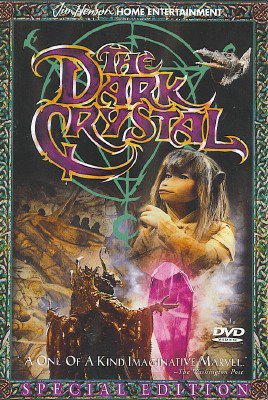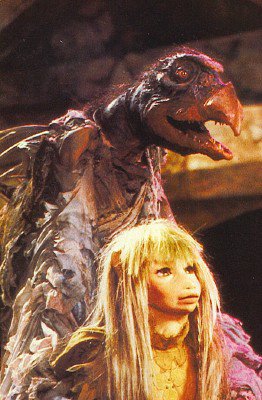 "Another World. Another Time. In the Age of Wonder. A thousand years ago, this land was green and good...until the Crystal cracked. A single piece was lost, a shard of the Crystal. Then strife began and two new races appeared: the cruel Skeksis and the gentle Mystics..."
"Another World. Another Time. In the Age of Wonder. A thousand years ago, this land was green and good...until the Crystal cracked. A single piece was lost, a shard of the Crystal. Then strife began and two new races appeared: the cruel Skeksis and the gentle Mystics..."And so begins The Dark Crystal, a remarkable Jim Henson genre film from the early 1980s. It's an elaborate film fantasy packed with scope, color, and vibrant, fascinating creations the likes of which the movies have never witnessed...not in over a hundred years of cinema history. And best of all, there's nary a human being in sight. This is an alien world complete unto itself, shared with the audience through the creative auspices of conceptual designer Brian Froud, production designer Harry Lange, scenarist David Odell and co-directors Frank Oz and Henson. Simply stated, the craftsmanship of this film is just astonishing.
By my assessment, The Dark Crystal is as rich and rewarding a fantasy enterprise as has yet been released theatrically (and yes, I'm counting the Jackson Lord of the Rings trilogy). This isn't a world of human beings in elaborate prosthetics or with pointed ears, or shrunken to appear as though they are gnome-like/hobbit creatures. On the contrary, this is the richly-imagined dimension of wonders like Aughra the Witch, Podlings, Land-Striders, Garthim, Gelfings, Fizzgigg, Crystal-Bats, and other fabulous inventions. It's the world of "Dream Fasting," "The Great Conjunction," and the Skeksis "Trial by Stone."
Perhaps the most remarkable thing about this film is that each of these creations had to actually exist to be filmed. By that, I mean they weren't created by a few keystrokes on a computer and then added to a live-action sequence later on. These things - the denizens of this unique world - had to be designed and built. They had to be a real physical presence on the set. They had to be puppeteered, wrangled and managed for the camera. Really, when you pause to think about what that means, you can detect what a labor of love this film must have been.
The Dark Crystal opens as the next "Great Conjunction" of three stars grows near. The Mystics and the Skeksis, two sides of the same coin, but splintered into two "opposite" races, await this cosmic coming together with vastly different emotions. The Skeksis fear it, for prophecy indicates that a Gelfling will heal the schism caused by the shattering of the Crystal, thus ending the Skeksis reign. In fact, the Skeksis are so afraid that they murdered all the Gelflings they could find to prevent a "Chosen One" from aborting their rule. On the other hand, the Mystics look forward to their eventual re-unification, and know that if the Gelfling fails now, evil will reign in the land for another thousand years...an eternity of darkness.
On the day that the elderly Skeksis Emperor and his opposite number among the Mystics finally dies, young Jen, a Gelfling is told of his role in the scheme of things by his dying master. He sets off on a dangerous quest to find the shard, the missing piece of the Crystal that can heal the land. His first stop takes him to Aughra's home in the mountains, where he locates the shard and escapes from the grasp of the skittering, clicking, hard-shelled foot-soldiers of the Skeksis, the Garthim. Later, Jen meets the only other surviving Gelfing, a female named Kira and her pet, Fizzgigg. She joins his quest, and together they make for the Skeksis castle, where the Dark Crystal awaits. But treachery is just around the corner as an outcast Skeksis, the Chamberlain plots for a triumphant return to the new Emperor's Court...
Although unfortunately derided by many critics upon its release (December 17, 1982) as nothing but another "muppet movie," The Dark Crystal is actually a robustly entertaining fantasy epic with a rich, mythological theme that went mostly unnoticed by people looking to detect the wires.
But instead the creators of the film make a great effort - both in word and in imagery - to countenance the theme of a world split down the middle, and suffering for the disunion. Several times throughout the opening narration, the voice-over reminds us that a "ritual grants no comfort on this day." Not for the Emperor of the Skeksis. Not for the Mystic either. And in terms of visualization, we see this theme repeatedly - for when a Skeksis dies (like the Emperor), the same thing happens to his opposite number among the gentle mystics. A bloody hand on a Skeksis results in a wound on the hand of a Mystic, and so forth. This is a literalization of the idea that united we stand, divided we fall. And that an action against an enemy may actually rebound and hurt an ally. In the United States today, we often hear how our citizens are "more divided" than ever; how the Red State vs. Blue State conflict is the prevailing dynamic. Yet what The Dark Crystal skillfully makes clear is that all races on this faraway planet (like all Americans, or all humans for that matter...) share the same fate. As the "angel"-like creature at the end of the film (the reunification of the Skeksis/Mystics) informs Jen, we are all a part of each other.
Delightfully, this unique theme is not treated in a heavy-handed fashion, and instead the filmmakers primarily get in their points via the auspices of canny visualizations. Again, production design is critically important in any reading of this film. The Mystics - gentle, wise creatures - are adorned in loose fitting robes, and seen in sandy earth tones. Their realm is of the "earth," an abode cut out of stone and clay. They seem to have few possessions and are hence not material creatures. They represent conventional "good" traits like humility, modesty, love of nature and environment.
By contrast, the Skeksis represent the dark side of humanity. Greed, avarice, malice. Their territory looks like a strip-mined wasteland, save for the castle. The Skeksis dress in elaborate, ostentatious robes of ornate design and bold color (crimson, gold, purple, and orange) and surround themselves with material wealth: giant hanging tapestries, high-backed banquet chairs, wide cushioned beds, and so forth. These material possessions are so important to the Skeksis that they appear literally hunched over by the weight of their cloaks and the elaborate, bony gear they wear over their spines.
Above all else, these creatures (who resemble nothing so much as giant buzzards...) value possessions. That's why it is the ultimate punishment in this society to be stripped of robes, as the Chamberlain is after his failed bid for leadership. When stripped of his costuming and place in Skeksis society, Chamberlain is revealed to be nothing but a scrawny, bony creation with bad posture. Underneath the costuming, these creatures are physically corrupt. In the case of both the Skeksis and the Mystics, the colors that we see, the costumes that they wear, the very imagery tells the viewer everything you need to know to understand their world.
The Dark Crystal is a movie that lives up to the often-utilized adjective, "wondrous," and it is a visual treat the likes of which has rarely been seen. Aughra's mountaintop residence, replete with a gigantic, metallic, spinning machine of a hundred parts, is a gorgeous bit of arcane design. The notorious banquet scene involving the Skekses is a truly disgusting set-piece, revealing the appetite of these creatures (and setting the stage, a year later, for Jabba the Hutt's appetites, one might guess...). And Kira's beautiful, overgrown forest is a splendid, lively creation...a place of overflowing life, where the very shrubbery seems to breathe.

One could make the argument that The Dark Crystal concerns a class society where the rich (the Skeksis) lord it over the poor (the Podlings), literally draining their vital life energies. You could debate Jen's role as "the Chosen One" and the prophecy he is so crucial a part of. And yes, all that is built-in, but what doesn't seem debatable here is the brawny visual imagination evidenced by the production team. This is a film that makes full use of the frame, and in many gorgeous location shots, stands far enough back for the audience to gain a real sense of scale....of the epic. The view of the Mystics on the march to the Castle -- a sun rise behind them -- is merely one example of the film's ability to capture and evoke a genuine sense of place. You must remember, after all, that these marching creatures set against a clouded sky and a low-hanging sun, are not real, but manmade creations. Yet placed against a real landscape, the illusion is impossible to see through.
Ultimately, The Dark Crystal succeeds beyond expectations because even in the midst of an utterly alien, utterly convincing landscape, the story speaks to a critical aspect of human nature. Aren't we all split, in some senses, right down the middle, just like the Skeksis and the Mystics? Hoping for the best, yet often clinging to the worst angels of our nature? This is a movie that "crystallizes" that dichotomy in an artistic fashion, and the result is a rare fantasy film of beauty, vision and epic scope.




No comments:
Post a Comment